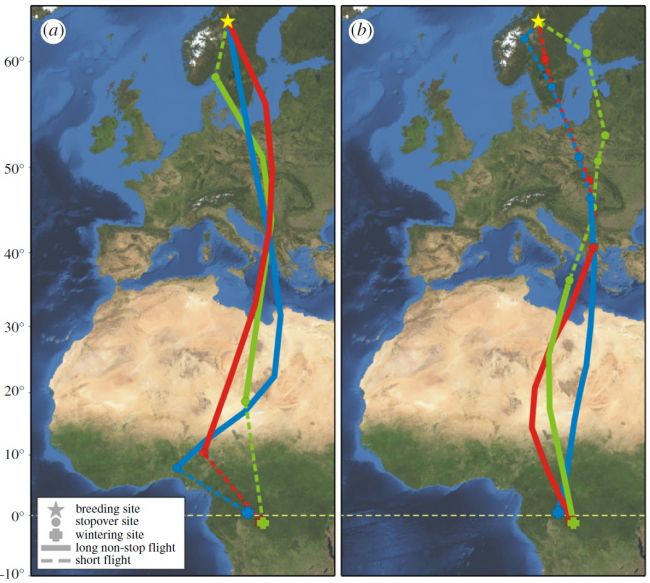Biology
26 luty 2013
A great snipe is a great snipe is a great snipe
 The great snipe Gallinago media is a middle-sized migratory charadriiform bird belonging to the sandpiper family. It resembles its close relative – the common snipe, but is slightly larger, has a shorter beak and more of the white colour in its tail. More important than the similarities and differences in its looks is the fact that the great snipe is much rarer than then common snipe.
The great snipe Gallinago media is a middle-sized migratory charadriiform bird belonging to the sandpiper family. It resembles its close relative – the common snipe, but is slightly larger, has a shorter beak and more of the white colour in its tail. More important than the similarities and differences in its looks is the fact that the great snipe is much rarer than then common snipe.
Migration
In the spring migratory great snipes can be spotted as early as the end of March, but the acme of migration takes place during the second and third week of April. The birds begin their autumn migration in August. In comparison to the spring migration, the one in autumn is more prolongated and, in Poland, it takes place mostly during the period from August until October. It is not easy to spot great snipes apart from their breeding sites during this time. This results from an exceptional migration strategy: great snipes, once started from a breeding site, can fly without stopping directly to their wintering sites. This has gained the great snipe the world record with respect to the distance of uninterrupted migration. Not a long time ago, in 2011, it has been discovered in Scandinavia that the birds can fly without stopping from their breeding site up to equatorial Africa. The first of the bird featured in this famous article has covered the distance of 6800 km in 84 hours, and the second migrated with the average speed of 96 km/h! What is interesting, during the spring migration the strategy was entirely different and the birds were making several stops before they reached the breeding sites.
Figure 1. Autumn (a) and spring (b) migration of three great snipe individuals. Source: Raymond H. G. Klaassen et al. Great flights by great snipes: long and fast non-stop migration over benign habitats. Biol. Lett. 2011
Habitat
 The great snipe belongs to the so-called wetland species. The localities where it occurs are diverse wetland areas with specific habitat characteristics. In Poland these are vast fens and flood-meadows in river valleys with their natural character more or less preserved. Unfortunately, following the intensive development of farming, such areas have become less and less common in our landscape. Today great snipes occur only where the man has not reached yet or where his traditional agrigulture remains in harmony with the surrounding nature. In the upper Narew River Valley the habitats of the great snipe are mainly extensively grazed meadows and pastures in the valley's flooding zone.
The great snipe belongs to the so-called wetland species. The localities where it occurs are diverse wetland areas with specific habitat characteristics. In Poland these are vast fens and flood-meadows in river valleys with their natural character more or less preserved. Unfortunately, following the intensive development of farming, such areas have become less and less common in our landscape. Today great snipes occur only where the man has not reached yet or where his traditional agrigulture remains in harmony with the surrounding nature. In the upper Narew River Valley the habitats of the great snipe are mainly extensively grazed meadows and pastures in the valley's flooding zone.
Food
To answer the question what does the great snipe eat, it is worth to take a look at its long beak. In birds, it is the form of the beak that usually tells about the type of food that they take. What does the great snipe need such a long beak for? It is that the way it forages consists mainly of probing the soft soil or mud with the beak. There, at a certain depth, it finds its food, which is composed of various invertebrates. Due to its high energy needs (associated with an "extravagant" reproductive system), the great snipe occurs in localities particularly rich in food. Some studies suggest that up to 90% of its diet consists of earthworms, which allows classifying it as a specialist species in terms of food preferences.
Unusual lekking behaviour
 What distinguishes the great snipe among other charadriiforms is its exceptional lekking behaviour. Just like the black grouse, males of the great snipe gather in small lek mating arenas (sites of courtship display), where they demonstrate their advantages in front of the females. In the final phase of the lekking – by posing, spreading their wings and demonstrating the white tail. In the same time they produce a characteristic sound resembling air bubbles released from a mire that has been stamped upon, with the associated subtle whistles. Depending on the space and acoustic conditions, the calling birds can be heard at a distance of 80-500 metres.
What distinguishes the great snipe among other charadriiforms is its exceptional lekking behaviour. Just like the black grouse, males of the great snipe gather in small lek mating arenas (sites of courtship display), where they demonstrate their advantages in front of the females. In the final phase of the lekking – by posing, spreading their wings and demonstrating the white tail. In the same time they produce a characteristic sound resembling air bubbles released from a mire that has been stamped upon, with the associated subtle whistles. Depending on the space and acoustic conditions, the calling birds can be heard at a distance of 80-500 metres.
The most persistent males can lek tirelessly the entire night, loosing in the same time up to 7% of their body weight! Photo Mateusz Matysiak
 Leks are often located on drier elevations with low-profile herbaceous plants, where usually a few up to a dozen or so individuals congregate. The display starts at dusk and, with breaks, lasts until dawn. The most persistent males can display tirelessly the entire night, loosing in the same time up to 6% of their body weight! They can, however, afford this "energetic extravagancy", because participation in lekking and acts of copulation are the only involvement of the males in the species survival. They do not participate in the parental care at any stage, and their only contribution in parenthood are the transmitted genes. Apart of lekking period great snipes lead a very secretive and rather solitary life, although small groups of individuals feeding together can be sometimes observed outside the breeding season.
Leks are often located on drier elevations with low-profile herbaceous plants, where usually a few up to a dozen or so individuals congregate. The display starts at dusk and, with breaks, lasts until dawn. The most persistent males can display tirelessly the entire night, loosing in the same time up to 6% of their body weight! They can, however, afford this "energetic extravagancy", because participation in lekking and acts of copulation are the only involvement of the males in the species survival. They do not participate in the parental care at any stage, and their only contribution in parenthood are the transmitted genes. Apart of lekking period great snipes lead a very secretive and rather solitary life, although small groups of individuals feeding together can be sometimes observed outside the breeding season.
Brood
Well concealed nests of great snipes are most commonly placed in sedge tussock or thick herbaceous vegetation. As in most charadriiform birds, the female typically lays 4 eggs, raising one brood per year. The hatchlings, nearly immediately mobile (precocial birds), hatch after 22-24 days, and under the mother's guidance learn to feed and to avoid predators. The young birds fledge in 21-28 days after hatching.



